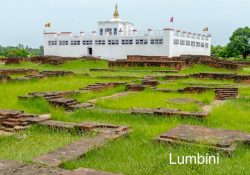
Lumbini, the Birthplace of Siddhartha:
Lumbini in Nepal, is a UNESCO World Heritage Site and one of the most sacred Buddhist pilgrimage sites in the world because it is the birthplace of Lord Buddha. Here Prince Siddhartha was born to Mayadevi. The Mayadevi Temple is said to be built at the spot of his birth. This holy site has numerous ruins of ancient temples and monasteries; many stupas; Pushkarini, the sacred pond and an age old sacred tree. Archaeologists have discovered a stone pillar from 345 B.C. This is an Ashokan Pillar which was built to commemorate the visit of Emperor Ashoka to worship at Lumbini.
Lumbini is a pristine, green forested monastic zone, situated at the foothills of Nepal Himalayas. It is 250 kilometres from Kathmandu, the capital of Nepal. Indian citizens do not require a Visa. Lumbini is easily accessible from Gorakhpur, Uttar Pradesh (India); which is 122 kilometres away; taking about 4 hours to reach by road.
Bodh Gaya, the place where Gautama Buddha was Enlightened:
Bodh Gaya in Bihar, India, is most significant and popular among all the Buddhist pilgrimage sites of the world. The Mahabodhi Temple houses that holy Bodhi Tree which is where Prince Siddhartha attained enlightenment and became ‘the Buddha’ meaning ‘the enlightened one’. This Temple is a UNESCO World Heritage Site. The first temple here was built by Emperor Ashoka and the present Mahabodi Temple is age old and built of ancient bricks. A sacred lotus pond and ‘Jewel Walk’, the path, where according to legends, lotus flowers sprung when Buddha walked by are present in the temple complex. 80 feet high statue of Lord Buddha stands beside the temple. There is an enriching museum too. For centuries people have been visiting this sacred site from all over the world. Numerous monasteries have been later built near the Mahabodhi Complex. They are Cambodian Monastery, Burmese Monastery, Tergar Monastery, Chinese Pagoda, Japanese Temple, Karma Temple, Royal Bhutanese Temple and more.
Buddha is worshipped by the Hindus too and besides all other Buddhist pilgrimage sites, Bodh Gaya is special for the Hindus too. Gaya, an important town, just 20 kilometres from Bodh Gaya is an extremely significant Hindu pilgrimage site. Gaya has an international airport and an extremely busy railway station.
Sarnath, the place of Buddha’s First Sermon:
Sarnath in Uttar Pradesh, India, situated 10 kilometres north-east of Varanasi, is one of the most significant Buddhist pilgrimage sites as Buddha’s first sermon was held here. The Deer Park is the holy site of His first preaching. Buddha taught ‘Dharma’ (Buddha’s philosophy) and Buddhist ‘Sangha’ (Community or Assembly) was formed for the first time. This spot is marked by a majestic stupa, The Dhamek Stupa, built during 500 C.E. Ruins and remains are scattered all over the vast area. There is an Ashokan Pillar. Sarnath also has a spectacular Thai Temple and garden of the modern times with an 80 feet tall statue of the Buddha.
Varanasi is also a Hindu religious hub. Lal Bahadur Shastri International Airport at Varanasi and Varanasi Junction are the nearest airport and railway station respectively.
Kushinagar, Where Buddha Breathed His Last :

Buddha Purnima
On this auspicious day, these four most sacred Buddhist Pilgrimage Sites are visited by thousands from all across the globe. Even in other Buddhist Monasteries or Hindu Temples, this day is observed with tremendous faith and zeal. The teachings of Lord Buddha show us a lighted path, it is beyond shackles of religion.
Buddham Sharanam Gachami, Dhammam Sharanam Gachami, Sangham Sharanam Gachami
Similar article written by me was published at4 Divine Buddhist Pilgrimage Sites in India

- Things to Do in Pondicherry - 16/08/2023
- Rain and Tea: A Stay at Makaibari Tea Estate This Monsoon - 22/07/2023
- 6 Simple Habits which Make a Great Difference in Life - 07/07/2023























This is the right website for anyone who hopes to find out about this topic. You understand a whole lot its almost hard to argue with you (not that I really will need toÖHaHa). You definitely put a fresh spin on a subject thats been written about for years. Wonderful stuff, just great!
I was very pleased to find this great site. I need to to thank you for ones time for this fantastic read!! I definitely loved every bit of it and i also have you book-marked to look at new stuff on your website.
Good information
Informative and useful post
Buddha’s life and teaching is much needed in the present situation when people are engaged in war, exploitation is very where,
Excellent writing and old photographs collection. I’m really overwhelmed.
Nice ❤